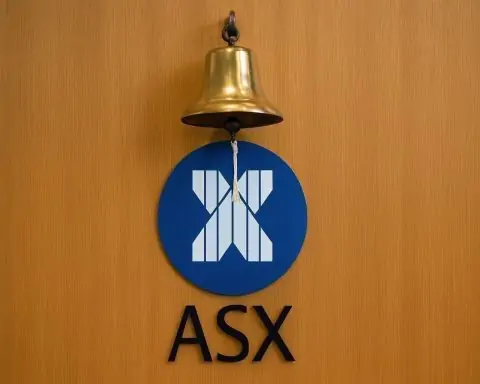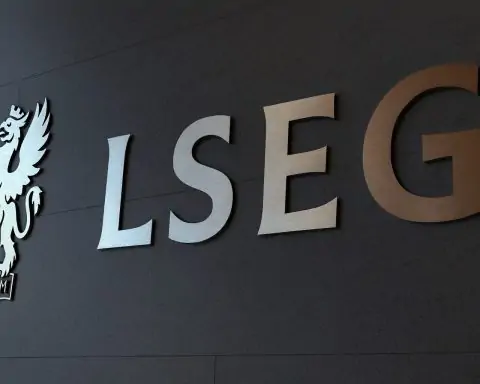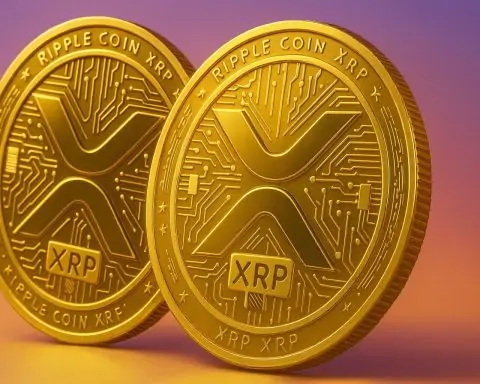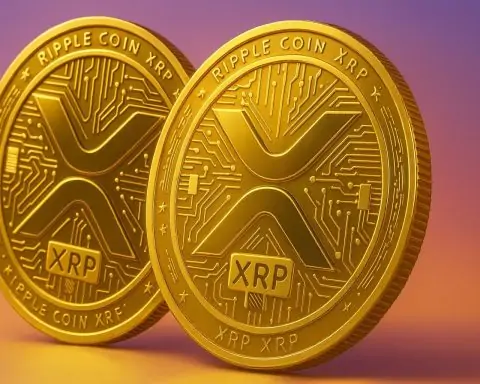- Bitcoin-Fueled Stock Spike: Zeta Network Group’s share price soared over 250% in a single day (Oct 7, 2025)after announcing a major Bitcoin-focused partnership [1]. The stock jumped from around $1.66 to over $5 in pre-market trading on the news. This comes on the heels of a prior 150% intraday surge on Sept 4, 2025when ZNB pivoted into crypto mining amid a Bitcoin price rally [2].
- Micro-Cap Volatility: Even after these jumps, ZNB remains a tiny micro-cap stock (~$10–11 million market value) with extreme volatility. It traded as low as $1.22 (52-week low on Sept 2, 2025) and as high as $3.41 (52-week high on Sept 4, 2025) within that week [3] – and just hit new highs above $5 on Oct 7. The 52-week range is $1.22 – $3.41 prior to the latest spike [4], illustrating the wild price swings. A recent 25-for-1 reverse stock split in August 2025 artificially boosted the per-share price as well [5]. The stock’s beta is ~2.5, indicating very high volatility [6].
- Crypto Pivot & Rebranding: Formerly known as Color Star Technology (ticker “ADD”), the company rebranded to Zeta Network Group (“ZNB”) in late August 2025 to reflect a strategic pivot toward cryptocurrency mining and blockchain-based entertainment tech [7] [8]. This change, effective Aug 22, included the 25:1 reverse split to maintain Nasdaq listing compliance [9]. ZNB’s business model now emphasizes Bitcoin-centric finance, including mining and deploying crypto assets, alongside its legacy online entertainment and music education platform.
- Latest Bitcoin Partnership: On October 7, 2025, ZNB announced a strategic partnership with SOLV Foundation, a crypto platform with $2.5 billion in total value locked [10]. Under this deal, Zeta will deposit its Bitcoin treasury holdings onto SOLV’s platform via a regulated custodian to earn yield, enhance transparency, and pursue tokenized financial products [11]. A joint steering committee will push adoption of SOLV’s Bitcoin token (SolvBTC) across multiple blockchains and co-develop real-world asset tokenization and structured yield products [12]. ZNB’s CEO hailed the partnership as a “transformative step” to strengthen its Bitcoin strategy [13].
- Weak Financials: Despite the crypto hype, Zeta Network’s fundamentals are very poor. In the most recent annual report (FY2024), the company had only $2.8 million in revenue against a net loss of about $26.9 million [14]. Operating expenses have vastly exceeded sales for years, and cumulative lossescontinue to mount (over $25 million lost in the past 12 months) [15]. ZNB’s market cap was under $4 million prior to the Oct 7 spike [16], reflecting investors’ low confidence. The company has no profitability in sight, and recent moves (like issuing shares to settle debt) suggest ongoing dilution [17].
- Market Sentiment & Analyst View: Market observers remain highly skeptical of ZNB. There is no Wall Street analyst coverage or official price targets on this nano-cap stock [18]. Independent analysis has flagged Zeta as a “high-risk micro-cap with red flags” – noting the reverse split, dire financials, and lack of institutional following [19] [20]. An AI-based stock rating system gives ZNB an abysmal 1/10 score (“Strong Sell”), indicating only a ~41% probability it will outperform the market in the next quarter [21]. In short, experts warn that speculative frenzy is driving the stock, and one commentary bluntly concluded that “ZNB shares remain unattractive to own in 2025” despite the recent rally [22].
Stock Performance as of October 7, 2025
Zeta Network Group’s stock has been on a rollercoaster in 2025. As of Oct 7, 2025, ZNB is trading around the mid-$5 range following a staggering one-day spike [23]. On the morning of Oct 7, shares jumped over 200%, triggered by a positive crypto partnership announcement (detailed below). This kind of explosive move is not new for ZNB – just a month prior, on Sept 4, the stock spiked nearly 150% intraday amid a Bitcoin price surge [24]. However, both times the stock’s initial euphoria partially faded: on Sept 4 ZNB gave back a chunk of gains by close, ending about +20% above its pre-spike levels [25].
Even with these pops, ZNB’s broader trend has been extremely volatile and predominantly downward. Over the past year the stock is down almost 100% on a split-adjusted basis [26] – essentially reflecting a collapse in value prior to the recent crypto-fueled rebounds. The 52-week low was $1.22 (hit on Sept 2, 2025) and it briefly hit a 52-week high of $3.41 on Sept 4 during the crypto pivot hype [27]. (Notably, these figures are adjusted for the 25:1 reverse split on Aug 22; pre-split, the stock was a sub-$0.20 penny stock.) With the Oct 7 surge above $5, ZNB has now broken above its previous yearly high, marking a new high-water mark for the year.
Market capitalization has swung dramatically in step with the share price. Before the Oct 7 news, Zeta Network’s market cap was only around $3.5 million at $1.66/share [28] – reflecting its status as a nano-cap company. After the 200%+ jump, market cap is roughly estimated around $10–11 million, still extremely small. The tiny float and low market cap help explain why the stock can skyrocket on any news: liquidity is low and volatility is high. Average daily volume has been in the few hundred thousand shares recently [29], which at penny-stock prices is only a few hundred thousand dollars traded – small inflows or outflows can move the needle significantly.
It’s also worth noting ZNB’s recent trading patterns: Prior to the Oct 7 announcement, the stock had been drifting lower throughout late September. Technical analysts pointed out that ZNB was in a “falling short-term trend” since mid-September, with a series of lower highs after the early Sept spike [30]. By Oct 6, the stock closed at $1.66, down roughly 10% over the prior 10 trading days [31]. In that context, the Oct 7 bolt from $1.66 to $5+ resembles a classic “news-driven short squeeze or momentum spike”. The stock’s beta (~2.5) and daily trading range (often 5–10% swings) confirm that ZNB is highly volatile [32] [33]. Traders should be prepared for unpredictable moves – indeed, the stock may just as quickly pull back after this spike, as many micro-cap rallies tend to be short-lived.
In summary, ZNB’s current stock performance is characterized by extreme volatility and speculative surges. At a price in the mid-single-digits (post-split), the stock is up sharply from last month’s lows, but its longer-term performance is deeply negative. Investors who bought ZNB a year ago or even in early 2025 would still be heavily underwater after multiple dilutions and price collapses. The recent rallies have provided opportunistic traders a chance to ride momentum, but also come with huge risk. ZNB’s stock essentially trades more on headline-driven sentiment than fundamentals, as we explore next.
Company Financials and Recent Earnings
Beneath the flashy stock moves, Zeta Network Group’s financial situation is quite troubled. The company’s latest reported financial results show minimal revenue and large losses, fitting the profile of a speculative penny stock rather than a thriving enterprise. According to the most recent annual filing (for the fiscal year ended June 30, 2024), Zeta Network’s annual revenue was a mere $2.83 million, while its net loss was approximately $26.9 million [34]. In other words, the company spent nearly $27 million (in operating and other expenses) to generate under $3 million in sales – a deeply unprofitable situation. Gross profit was negligible, and heavy operating expenses (reportedly including investments in new business lines) drove the large loss.
Those figures continued a trend of chronic unprofitability: in the prior year (FY2023), revenues were similarly low (around $6.8 million) and net losses even larger (over $37 million) [35] [36]. The company’s accumulated deficit has grown, raising questions about its ability to continue as a going concern without new financing. Indeed, recent SEC filings indicated substantial doubt about continuing operations absent additional capital, which likely motivated some of the strategic pivots and financing maneuvers we’ve seen.
On September 23, 2025, ZNB had an earnings release or update scheduled (as per Nasdaq’s calendar) [37], which presumably would cover the quarter ending June 30, 2025 or annual results. While detailed quarterly figures aren’t widely reported in media, the pattern is expected to be similar – minimal revenue from its legacy entertainment and education business, continued losses, and perhaps early expenditures related to the new crypto mining initiative. Notably, ZNB does not host regular earnings calls and has scant analyst following, so official guidance is non-existent.
To shore up its shaky balance sheet, Zeta Network Group has taken dilutive actions. Most significantly, on September 4, 2025 (the same day as the crypto pivot news), the company settled outstanding convertible promissory notes by converting them to equity [38]. In a “Payoff Letter Agreement” with note holders, ZNB issued Class A ordinary shares at a fixed price of $1.15 per share to extinguish the debt [39]. This move eliminated the liability of those notes (improving the balance sheet by removing debt), but it also greatly increased the share count, diluting existing shareholders. Following the 25-for-1 reverse split in August, ZNB had roughly 585,000 Class A sharesoutstanding [40]. The conversion of notes at $1.15 added a substantial number of new shares – likely bringing total shares outstanding to over 2 million (as some data now reflect ~2.12 million shares) [41]. This dilution partly explains how the market cap can be under $4 million at a $1.66 share price [42] – the share count rose dramatically post-conversion. The convertible note payoff was framed by management as a positive, “streamlining financial obligations” and giving ZNB more flexibility [43]. Indeed, clearing the debt removes interest costs and default risk, but it came at the expense of equity dilution.
Another financial maneuver was the 25-for-1 reverse stock split executed on August 22, 2025 [44]. This corporate action multiplied the stock price by 25× (while dividing share count by 25) in order to regain compliance with Nasdaq’s $1 minimum bid price rule (ZNB’s price had fallen well below $1 prior). The reverse split did not change any fundamentals – it’s essentially a cosmetic change – but it reduced the number of shares (from ~14.6 million Class A shares pre-split to about 585k post-split) [45]. Often, a reverse split is seen as a red flag in itself, signifying a struggling company. In ZNB’s case, this was indeed a necessary step to avoid delisting, and it happened alongside the name change and strategic refocus.
In terms of assets, one potentially significant item is the company’s cryptocurrency holdings. Zeta Network’s new strategy involves holding Bitcoin (and possibly other crypto assets) on its balance sheet as part of its treasury. However, it’s unclear how large their Bitcoin holdings are at this point. The recent partnership announcement (with SOLV) implies ZNB does have some Bitcoin treasury that it wants to put to work (perhaps earned via crypto mining operations or purchased). If the company holds a meaningful amount of Bitcoin, the value of those holdings could bolster the balance sheet when crypto prices rise – but again, no concrete figures have been given in press releases. Any such holdings would also introduce financial risk, as the company’s asset values would fluctuate with the crypto market.
Overall, Zeta Network Group’s financials depict a company in distress. Revenues from the legacy business (online entertainment and music education services) are very low and not growing meaningfully. The new crypto-mining initiative has yet to produce material revenue (and is costly to start up). Losses remain huge relative to the company’s size. Cash on hand has likely been minimal (the last report hinted at only ~$1–2 million in cash, and the going-concern warning suggests they needed to raise funds). The payoff of convertible notes and possibly other capital raises (or asset sales) were crucial just to stay afloat. Prospective investors should be aware that ZNB will likely need to raise additional capital if it continues to burn cash – which could mean further dilution (e.g. issuing new shares or warrants, possibly taking advantage of any stock price spikes to sell equity). In summary, the financial foundation of ZNB is very weak, and its soaring stock price is disconnected from its fundamentals.
Notable Recent Developments and News (Fall 2025)
Zeta Network Group’s storyline in recent months has been eventful. The company has dramatically shifted its business focus, undergone corporate changes, and announced headline-grabbing crypto ventures. Here are the key developments in the past few weeks leading up to October 7, 2025:
- Corporate Name Change & Crypto Pivot (Aug 2025): On August 20, 2025, the company (then still Color Star Technology, ticker “ADD”) announced it would change its name to Zeta Network Group and its Nasdaq ticker to “ZNB” [46]. This rebranding took effect on August 22. Alongside the name change, Color Star/Zeta implemented a 25-for-1 reverse stock split [47]. The official reason given was to “better reflect the company’s new business strategy in cryptocurrency mining and AI integration in entertainment” [48] [49]. Essentially, management signaled a strategic pivot away from the prior core (which was online music education and celebrity entertainment content) toward cryptocurrency and blockchain ventures. This pivot was likely spurred by the rising interest in crypto and the company’s need for a growth narrative. The stock initially popped on the announcement of the upcoming changes – it appears traders speculated on the new ticker and reduced float, as low-priced stocks sometimes rally after reverse splits or sector pivots. However, that excitement was short-lived; by late August the stock drifted back down below the split-adjusted $2 level as no immediate new business had materialized yet.
- Crypto Mining & Bitcoin Treasury Strategy (Early Sep 2025): The first week of September brought the next big news. Around Sept 3–4, 2025, Zeta Network Group announced that it had begun cryptocurrency mining operations and was aligning itself closely with Bitcoin’s fortunes. This was accompanied by a press release or media piece highlighting that ZNB’s share price is now tied to Bitcoin’s momentum, as the company had effectively become a micro-cap crypto miner. Indeed on Sept 4, ZNB’s stock surged ~150% intraday in tandem with a sharp jump in Bitcoin prices (Bitcoin spiked from just under $109,000 to above $112,000 that day) [50] [51]. The market perceived Zeta as a “crypto play”, so when Bitcoin itself rallied to new highs, speculators piled into ZNB. The company’s strategic messaging emphasized this crypto pivot: they highlighted plans for Bitcoin mining and maybe other blockchain initiatives, attempting to ride the wave of investor appetite for anything crypto. However, savvy commentators were quick to caution that ZNB’s fundamentals didn’t justify the hype. One Yahoo Finance analysis on Sept 5 noted that “Zeta Network stock rallied on [the] pivot, but ZNB shares remain unattractive to own in 2025”, citing the company’s lack of real earnings and the gimmicky nature of the crypto gamble [52]. Still, for a brief moment, ZNB became a momentum darling – its price ran from the low $1s to over $3 in early September, making it one of the top percentage gainers in the market.
- Convertible Debt Settlement (Sept 4, 2025): As discussed in the financials section, the company also used the early September window to clean up its balance sheet via a debt-to-equity conversion. On Sept 4, ZNB entered an agreement with holders of its January 2025 convertible notes to convert all outstanding principal into shares at $1.15/share [53]. This effectively settled the debt in one stroke. The timing is notable: doing this on Sept 4 means it likely leveraged the stock’s elevated price (post-split) and renewed trading volume. It’s possible the note holders were eager to convert and sell into the rally (which could explain why the stock’s intraday peak didn’t hold and it “reversed much of its gains by close” on Sept 4 [54]). In any case, the outcome is that Zeta Network Group eliminated some liabilities and increased its equity base. The company touted this as improving its “financial position and flexibility” [55]. However, existing shareholders were diluted, and the share float increased. This development was reported as a positive step, but it also underscores that ZNB is essentially financing its operations through dilutive stock issuance, a common pattern for micro-cap firms.
- Strategic Partnership with SOLV (Oct 7, 2025): The most significant current news – and the catalyst for the latest stock explosion – is Zeta Network Group’s announcement on October 7 of a strategic partnership with SOLV Foundation to advance “Bitcoin-centric finance” [56]. According to the press release, ZNB is teaming up with SOLV (which operates an institutional crypto platform) to deploy Zeta’s Bitcoin holdings into SOLV’s DeFi ecosystem. Key points of the partnership:
- ZNB will deposit its Bitcoin Treasury onto SOLV’s platform, which boasts $2.5 billion TVL (total value locked), to earn yield and liquidity [57].
- The Bitcoin will be held with a regulated third-party custodian approved by ZNB, ensuring transparency and auditability (a nod to compliance given ZNB’s Nasdaq listing) [58].
- ZNB and SOLV are forming a joint steering committee with senior members from both firms [59]. This committee’s mission is to promote SolvBTC adoption across multiple blockchains (specifically Solana, Base, and Ton networks) [60] [61]. SolvBTC appears to be SOLV’s Bitcoin-backed token or liquidity product.
- The partnership will also explore tokenized real-world assets and structured yield products, and pursue joint research on corporate Bitcoin use-cases [62] [63]. Essentially, ZNB is positioning itself at the forefront of innovative crypto-finance products (for a company of its size, this is ambitious).
- Importantly, both companies emphasized regulatory compliance: They commit to adhering to SEC and Nasdaq requirements throughout these crypto activities [64]. This likely references the need to avoid running afoul of securities laws or listing rules while dealing in tokenized assets.
- Other News and Context: It’s important to mention that ZNB’s story is unfolding against a backdrop of crypto industry excitement in 2025. Bitcoin’s price has been at record highs (more on that in the next section), and there’s a trend of companies embracing crypto strategies. Zeta Network is part of this trend – much like how some other penny-stock companies have pivoted to crypto or blockchain to revive investor interest. For instance, in the same timeframe, a tiny company called CleanCore (ticker ZONE) announced a bold move to create a Dogecoin treasury, which initially caused a stir (and stock spike) but then led to a sell-off as investors questioned the viability [68]. ZNB’s pivot to Bitcoin and DeFi is a similar high-risk, high-reward gambit. Additionally, Zeta Network had previously made headlines in its Color Star era for unusual ventures (like metaverse projects, celebrity partnerships in entertainment, even boxing events) [69], often with mixed results. The shift to crypto appears to be the latest chapter in a company that is continually reinventing itself to chase hot trends.
In summary, the past few months have radically transformed the narrative around ZNB. A rebranding and reverse split in August, a crypto mining pivot in early September, and now a Bitcoin finance partnership in October have collectively turned Zeta Network Group from an obscure penny stock into a talking point on crypto-trader forums. Each step has been accompanied by big stock movements – mostly speculative surges. Going forward, investors will be watching how (and if) ZNB actually capitalizes on these partnerships and new strategies, or whether this will follow the classic pattern of a brief rally followed by retrenchment once the initial buzz fades.
Market Sentiment and Expert Commentary
Market sentiment toward Zeta Network Group can be described as a mix of speculative enthusiasm and deep skepticism. On one hand, the stock’s dramatic moves show that a cadre of retail traders and momentum chasers are very bullish (at least in the short term) whenever ZNB announces a crypto-related development. On social media platforms like Stocktwits and trading forums, ZNB has periodically trended as a “high flyer” or potential short-squeeze candidate. The very positive price action on news like the SOLV partnership indicates strong speculative sentiment – traders piling in with hopes of quick profits. ZNB essentially has become a “lottery ticket” stock, where the prospect of catching a multi-bagger outweighs traditional valuation concerns for these speculators.
However, finance professionals and seasoned analysts have largely been bearish or cautious on ZNB, viewing it as an extremely high-risk penny stock. It’s telling that no major Wall Street analysts cover Zeta Network Group at all [70]. The company is too small and unproven to warrant coverage from investment banks. That means no official ratings or earnings forecasts are available. The lack of coverage itself often signals that institutional interest is minimal – ZNB is mostly traded by retail players, not large funds.
Independent investment commentators who have looked at ZNB generally issue warnings. For example, an analysis on Yahoo Finance (syndicated via Barchart) around Sept 5, 2025 took a very dim view of the stock’s fundamentals despite its crypto pivot. The article noted that ZNB remains a micro-cap with numerous red flags: a recent reverse split (often a bad sign), “dire financials” (net losses far outweighing revenue), and zero institutional coverage [71] [72]. It emphasized that the company’s alignment with Bitcoin doesn’t change the fact that it is unprofitable and dilute. In a blunt assessment, the analyst concluded that “ZNB shares remain unattractive to own in 2025”, even with the crypto rally [73]. In other words, the stock’s huge jump was seen as disconnected from any realistic valuation – a classic penny stock pump tied to a trendy story.
Another perspective comes from algorithmic and quant models. Danelfin, an AI-driven stock analysis platform, assigns ZNB an “AI Score” of 1 out of 10, which equates to a “Strong Sell” signal [74] [75]. This score is based on a combination of fundamental, technical, and sentiment factors. According to Danelfin’s data, ZNB has a significantly below-average probability (only ~41%) of outperforming the market in the next 3 months, compared to a ~54% baseline for typical stocks [76]. Essentially, the AI is picking up on the poor fundamentals and perhaps the overextended technicals. Similarly, TipRanks’ technical analysis summary recently flagged ZNB with a “Strong Sell” signal as well, and noted the “Current Market Cap: $743.6K” (likely outdated data before the share count update) which underscores how tiny the company is [77]. The high short interest (Danelfin cites ~42% of float sold short [78]) also reveals negative sentiment – a lot of traders are betting on the stock’s decline, perhaps viewing the crypto spikes as opportunities to short an overvalued micro-cap. Such a high short float can create the conditions for short squeezes, which may partly explain the magnitude of ZNB’s jumps (if shorts rushed to cover during the Oct 7 rally, that buying would fuel an even bigger spike).
From the market sentiment standpoint, ZNB is basically a battleground between speculative bulls and skeptical bears. Bulls are excited about the company’s crypto announcements, dreaming that Zeta Network could ride the Bitcoin wave and maybe transform into a much larger enterprise (or at least that the stock could be pumped higher by momentum). Bears (and realists) point to the company’s history and finances: ZNB has reinvented itself multiple times (from education to metaverse to crypto mining) which is often a red flag, it consistently loses money, and the management’s grand plans have yet to deliver tangible results.
Even some crypto-sector commentators advise caution. After ZNB’s September run-up, one report observed that while the Bitcoin mining pivot gave the stock a buzz, “the lack of profitability and extreme volatility… make ZNB a speculative investment rather than a viable long-term growth opportunity.” [79] ZNB’s beta of ~2.5 and “meme-like” spikes are attractive to short-term traders but inimical to long-term investors. Essentially, market sentiment on ZNB’s long-term prospects is bearish, whereas short-term trading sentiment is opportunistic/bullish during news cycles.
It’s also useful to compare ZNB’s reception to that of similar companies. For instance, MicroStrategy (MSTR) – a well-known company that holds billions in Bitcoin – is often cited as a (much larger) example of a stock tied to Bitcoin’s fortune. MicroStrategy’s CEO Michael Saylor famously turned the firm into a Bitcoin proxy, and its stock moves with BTC price. Zeta Network Group is attempting a mini version of that play (using Bitcoin on its balance sheet to create value). But unlike MicroStrategy, which had a real software business and significant assets to start with, ZNB is starting from a place of weakness. Thus, experts are skeptical that ZNB can emulate any success just by copying a crypto-treasury strategy.
In the retail trading community, sentiment can swing wildly. Right now, after the SOLV deal, the mood on ZNB-specific message boards is euphoric – one could observe many traders boasting about huge percentage gains in a day, and speculating that the stock could go even higher if more crypto news drops. However, seasoned traders often warn that these are “greater fool” rallies – they can implode as fast as they explode. Any sign of the momentum stalling could see many of those same traders rush for the exits. The fact that ZNB has no real earnings and will likely need more dilution is not lost on everyone; some posts express concern that the company might take advantage of the price spike to issue new shares or that insiders might sell.
To sum up, expert commentary on ZNB is largely negative: the stock is regarded as a speculative play disconnected from fundamentals. Market sentiment among professionals is cautious to bearish, focusing on the high risk. Retail sentiment is temporarily bullish during news-driven spikes, focusing on the high reward (for those who time it right). This dichotomy is common in penny stocks. It means anyone considering ZNB should be prepared for volatility and understand that the company’s long-term value is highly uncertain. In the next section, we’ll look at what, if anything, analysts and forecasters expect for ZNB’s future – bearing in mind the lack of formal coverage.
Analyst Forecasts and Future Outlook
Given Zeta Network Group’s tiny size and speculative nature, traditional analyst coverage is absent – there are no consensus earnings forecasts, no price target from big banks, and no Bloomberg terminal full of analyst recommendations for ZNB. This is not unusual for micro-cap stocks under $50 million market cap. As a result, the “analyst forecasts” for ZNB have to be gleaned from alternative sources: independent research, quantitative models, and the company’s own stated plans.
Wall Street Analysts: As of October 2025, no sell-side analyst has issued a rating or target price for ZNB [80]. Firms like Yahoo Finance list “Analysts: N/A” and “Price Target: N/A” for ZNB [81]. In practical terms, this means the professional investment community is largely ignoring Zeta Network Group, likely due to its unstable financials and the volatility that makes it hard to model. Without any earnings estimates, we don’t have P/E or growth projections to cite – ZNB’s earnings are negative, and will likely remain so in the near future.
Company Guidance: ZNB itself has not provided specific numerical guidance for revenue or profit going forward. What they have provided is strategic direction. The company’s outlook centers on growing its crypto-related operations. They have indicated plans to:
- Expand Bitcoin mining (possibly by acquiring mining rigs or facilities, or partnering with miners) to generate revenue from block rewards.
- Utilize partnerships like the SOLV Foundation deal to earn yield on crypto assets and potentially launch new financial products (like tokenized assets) that could create revenue streams or intellectual property.
- Continue leveraging their “Color World” entertainment platform but now with integration of blockchain/AI, though the prospects of that business are unclear.
- Maintain Nasdaq listing and compliance (hence the reverse split), which implies they want to avoid falling below $1 again – possibly through improving the business or further corporate actions.
One could interpret these as the company expecting that 2025–2026 will be a transformational period: if Bitcoin’s bull market continues, ZNB hopes to ride that wave and maybe turn its crypto endeavors into actual earnings. However, this remains speculative. No timeline or quantitative targets (e.g., “mine X BTC per month” or “achieve profitability by Y date”) have been publicly stated.
Analyst Expectations (if any): In the absence of official coverage, some financial websites use algorithms or AI to project trends. For example, StockInvest.us (which we accessed above) analyzes moving averages and trendlines to issue a short-term forecast. As of Oct 6 (before the big jump), their algorithm had ZNB as a “sell candidate” due to a prevailing downtrend, noting that if the stock stays at current or higher levels, the prediction could turn more positive [82]. Of course, the Oct 7 spike broke all those short-term models – any prior chart-based forecast is now obsolete, and a new trend (potentially upward momentum) might be in play until it isn’t.
We also have the Danelfin AI model, which effectively predicts ZNB is more likely to underperform than outperform in the next 3 months (only a 41% chance it beats the S&P 500) [83]. That implies an expectation that the stock will fall or at least lag the market once the dust settles. Danelfin classifies ZNB as “High Risk” with poor fundamental and technical scores [84]. This is akin to an analyst saying “the stock is a Strong Sell unless you are gambling.”
No analyst price targets exist, but for context, before the crypto pivot, ZNB (then Color Star) was trading around $1–2 (post-split) and drifting lower. Many micro-cap observers would have expected it to eventually go to zero or get delisted, absent a major change. The crypto pivot has given it a new lease on life, but analysts would likely still value it on fundamentals which are near-zero. One way to estimate an intrinsic value is to consider its equity: if we take even a generous view – say ZNB somehow generates a few million in revenue from crypto in 2026 with a slim chance of breaking even – its market cap of ~$10 million might already be pricing in a lot of optimism. Traditional valuation metrics (price-to-sales, etc.) are sky-high given $2.8M revenue vs $10M+ market cap (over 3.5× P/S, which is high for a money-losing firm). If anything, a cautious analyst might set a target price back in the low single digits (or even below $1) once the hype settles.
Looking further out, what would it take for ZNB to justify, say, a $5 share price on fundamentals? With ~2 million shares, a $5 price means a $10M valuation. For a company like this, an analyst might say a 2x–3x P/S ratio is reasonable if growth is expected. That would require $3–5 million in annual revenue. Currently they do ~$2–3M, so they’d need to roughly double revenue and dramatically cut losses to fundamentally merit ~$10M valuation. That’s not impossible if crypto mining picks up or if they launch a successful product, but it’s far from certain. Profits are an even taller order – they’d need to drastically reduce costs or have some windfall.
Analyst sentiment on the sector: More broadly, analysts covering the crypto-mining or blockchain sector have mixed views for 2025–2026. On one hand, the crypto bull market (Bitcoin over $100k) has them bullish on the prospects of companies in the space – for example, many expect Bitcoin miners and related firms to see improved financials as Bitcoin’s price hits new highs. On the other hand, they often favor established players (like Coinbase, Riot, Marathon, etc.) with real operations, rather than tiny newcomers. A micro-cap like ZNB likely wouldn’t hit their radar unless it accomplishes something extraordinary.
Near-Term Catalysts: In the near term (the coming weeks and months), the outlook for ZNB will depend on a few key factors:
- Follow-through on the SOLV partnership: Investors will watch for any concrete updates – e.g., “ZNB has deposited X BTC on SOLV platform and expects Y% yield,” or perhaps development of a new token or product from this alliance. If nothing more is heard, enthusiasm could fade. If tangible progress is announced, it might sustain interest.
- Bitcoin price trajectory: Since ZNB has tied its fate to Bitcoin, if BTC continues rising (some forecasts see $150k–$200k by end of 2025) [85], that could keep sentiment bullish on crypto stocks like ZNB. Conversely, a sharp pullback in Bitcoin could severely hurt ZNB’s stock (both through sentiment and any direct impact on their mining/yield earnings). As one analyst pointed out, ZNB’s share price is highly correlated with BTC movements now [86]. So essentially, ZNB’s outlook is partly a bet on Bitcoin’s outlook.
- Potential equity raise: It would not be surprising if ZNB seizes this high share price to issue new shares (e.g. via an ATM offering or secondary) to raise cash for its initiatives. If they announce a capital raise, it could pressure the stock in the short term (as dilution looms) but might provide funding to pursue their crypto strategy (which could be positive longer-term if used wisely).
- Regulatory and compliance events: ZNB must maintain Nasdaq compliance. Post-split, it’s above $1, but any sustained fall could put it at risk again. Also, any SEC scrutiny of micro-cap crypto stocks could be a risk factor (though nothing specific has been flagged, the SEC has been wary of crypto-related penny stocks historically).
Long-Term Vision: If one takes the most optimistic view (perhaps what ZNB’s own management hopes), a few years down the line Zeta Network Group could transform into a niche player in the crypto financial ecosystem – perhaps running a profitable Bitcoin mining operation and managing a portfolio of digital assets that generate yield, effectively making it a mini crypto asset manager. In that bullish scenario, the company could try to uplist to a higher tier or attract institutional investors, and the stock could be multiples of its current value. However, this scenario assumes flawless execution, favorable crypto markets, and no further shareholder dilution – a combination that skeptics find unlikely.
The more conservative expectation is that ZNB will continue to face challenges turning its crypto pivot into sustainable profits. Analyst-equivalents might expect the company to continue losing money for the next year or two, possibly requiring additional financings. If Bitcoin’s bull run falters, ZNB’s stock could retrace back to pre-pivot levels. Essentially, the base-case (without extreme optimism) might be that ZNB drifts back down after the hype, unless it delivers surprisingly strong results.
In summary, analysts (to the extent they weigh in) and smart money are very cautious on ZNB’s future. There is no consensus target or estimate, but the prevailing attitude is that the stock’s recent surge is speculative. Any investor considering the long-term should do so with the understanding that ZNB is trying to reinvent itself in a very volatile industry. Without clear evidence of a turnaround (revenue growth, narrowing losses), an objective forecast would likely be that ZNB’s share price could remain highly volatile and potentially trend lower once current excitement fades. Only if the company’s crypto initiatives bear fruit (and Bitcoin remains strong) might we see a stable upward trajectory. At this stage, ZNB is more of a gamble on crypto momentum than an investable business, which is why formal analyst expectations are largely absent or negative.
Industry Trends Influencing ZNB’s Performance
Zeta Network Group’s fortunes are now closely tied to the broader cryptocurrency and blockchain industry trends, especially as it has pivoted fully into the crypto space. Several key market and industry factors are influencing ZNB’s performance in 2025:
- Bitcoin’s Bull Market: The single biggest factor is the price of Bitcoin. 2025 has seen Bitcoin reach unprecedented levels – by mid-year it hit record highs around $120,000+ [87], fueled by strong institutional demand (especially after the approval of U.S. spot Bitcoin ETFs) [88]. By early October, Bitcoin has been trading well above the $100k mark. This macro trend creates a favorable tailwind for companies associated with crypto. ZNB’s huge rallies in September and October directly coincided with bullish moves in Bitcoin. When Bitcoin jumped above $109k in early Sept, ZNB’s stock jumped as well [89]. The logic for investors is that if Bitcoin prices are high, a crypto-mining company or a company holding Bitcoin on its balance sheet (like ZNB) should increase in value. Indeed, ZNB has openly aligned itself with Bitcoin-centric strategy, so rising Bitcoin prices drive positive sentiment and speculation in ZNB. Conversely, any downturn in Bitcoin (say a drop below $100k) could quickly sour sentiment. We’ve seen historically that crypto stocks can be extremely correlated to BTC: for example, in previous years when Bitcoin fell, crypto miner stocks plunged even more. Therefore, the ongoing “crypto euphoria” – some analysts project Bitcoin could reach $150k or more by end of 2025 [90] – is a critical supportive trend for ZNB. It’s attracting more investors to the crypto equity space and providing ZNB with an environment where its pivot looks smart (at least for now).
- Crypto Adoption & Corporate Treasury Trends: Another relevant trend is the increasing adoption of crypto by corporations and institutions. Zeta Network Group’s strategy of using Bitcoin as part of its corporate treasury and engaging in DeFi reflects a broader narrative. Big-name examples include MicroStrategy accumulating Bitcoin as a treasury reserve and Tesla (in earlier years) buying Bitcoin. In 2025, even governments and large institutions are more involved in crypto. For instance, the approval of Bitcoin ETFs has legitimized holding Bitcoin for mainstream investors [91]. We also saw references that a “Trump Media $2.5B Bitcoin investment” and other such moves were making headlines [92]. The idea of Bitcoin as a corporate asset is gaining traction (it was even listed as a top narrative for the 2025 bull run [93]). ZNB is trying to surf this trend by emphasizing its Bitcoin holdings and using phrases like becoming “a Nasdaq-listed leader in Bitcoin-centric digital asset finance” [94]. If more companies announce adding Bitcoin to their balance sheets or adopting blockchain tech, it generally boosts sentiment for all crypto-related stocks. ZNB, being one of the few micro-caps that explicitly rebranded around Bitcoin, stands to gain from this narrative. However, this also means ZNB is vulnerable if the trend reverses – e.g., if regulators crack down on corporate crypto holdings or if major players sour on the idea due to volatility.
- Decentralized Finance (DeFi) and Yield Opportunities: ZNB’s SOLV partnership places it in the context of DeFi and crypto yield generation. In the crypto world, 2024-2025 saw a boom in platforms offering yields on Bitcoin and stablecoins via decentralized protocols. The concept of tokenizing assets and earning yield is a hot trend. SOLV’s platform, which ZNB is leveraging, is part of this DeFi landscape providing “on-chain finance”solutions [95]. Industry-wide, there’s a push toward tokenization of real-world assets (RWAs) – things like real estate, bonds, etc., being put on blockchain and integrated with DeFi. The partnership explicitly mentions pursuing tokenized real-world assets and structured yield products [96]. This aligns with one of the top crypto narratives (RWA tokenization was cited as a trend for the bull run in some reports) and suggests ZNB wants to be on the cutting edge. If DeFi platforms continue to grow and deliver high yields (while avoiding major regulatory issues), ZNB could benefit by being an early mover in that space among public companies. However, the DeFi sector is also fraught with risks – hacks, regulatory scrutiny (e.g., the SEC’s stance on yield programs), and volatile returns. A negative event in the DeFi space could impact ZNB’s plans (for example, if SOLV or similar platforms ran into trouble, that would reflect on ZNB’s strategy).
- Regulatory Environment: The crypto industry in 2025 is operating under increasing regulatory clarity in some areas (such as ETFs being approved, which is positive) but also heightened scrutiny in others (the SEC and global regulators keeping an eye on crypto companies). ZNB’s press release makes a point that it will adhere to SEC and Nasdaq requirements [97], suggesting they are keenly aware of regulatory risk. Being a US-listed company doing crypto finance means ZNB must be careful about securities laws (e.g., if they issue tokens or offer yield products, they need to ensure compliance). The trend toward regulation – both in the US and internationally – could be a double-edged sword. On one hand, clear regulations (like defining tokens, allowing ETFs, etc.) help legitimization, which is good for companies like ZNB. On the other, stricter rules might limit what ZNB can do (for instance, if the SEC were to say that certain DeFi yield programs constitute unregistered securities offerings, ZNB would have to avoid those). The industry trend is moving toward greater oversight of crypto, which ZNB will have to navigate. Any misstep (like a compliance failure) could be devastating for a small company. Conversely, if ZNB manages to remain compliant and even help shape best practices, it could gain a first-mover advantage in a regulated crypto finance niche.
- Crypto Market Sentiment & Related Stocks: ZNB’s performance is also influenced by how the market at large treats crypto-related stocks. In 2025, we’ve seen periods where crypto miners and blockchain stocks soar collectively (e.g., when Bitcoin broke $100k, crypto mining stocks jumped 7–8% in a day [98] [99]). There’s a sort of sympathy play dynamic – when one small crypto stock runs, traders often look for other names in the sector. ZNB might have benefited from this as well. For example, when news hit that Trilogy Metals (a different sector stock) more than doubled on a government stake (as an aside from trending news) or when other penny stocks made outsized moves, momentum traders scan for the next runner. ZNB, with its low float and crypto angle, becomes a prime candidate. The industry trend of retail traders hunting for volatile “momentum trades” is very much a factor. It’s part of the meme-stock culture that has persisted post-2021, now extending into crypto penny stocks in 2025.
- Technology and AI Integration: Although less immediately impactful than crypto, ZNB’s business description still mentions use of artificial intelligence in entertainment [100]. The year 2025 has been marked by a lot of AI hype in the stock market as well, with companies adding AI angles to boost interest. ZNB’s earlier press implied they are integrating AI into their platform (perhaps AI-driven music or education services). While crypto is the main story, any industry trend in AI could also influence ZNB’s narrative. If AI remains a buzzword, ZNB might highlight it more to ride that trend too. That said, the AI angle is secondary for ZNB at present compared to crypto.
- Industry Competition and Collaboration: ZNB is operating in a highly competitive and rapidly evolving space. The crypto mining industry includes much larger players (Marathon, Riot, etc.) that have economies of scale. ZNB likely cannot compete head-on in mining hashpower, so its strategy of partnerships (like SOLV) and niche focus is key. Industry trends of consolidation could either hurt or help – for example, if small miners get acquired by bigger ones, would ZNB be an acquirer or a target? Uncertain, but possible. Also, trends like shifting mining to renewable energy, or geographic shifts (regulations causing miners to move) could indirectly affect ZNB if it mines or invests in miners.
In essence, ZNB’s performance is intertwined with the broader crypto market cycle. Right now, that cycle is positive (bullish), which has been a boon for ZNB. The phrase “a rising tide lifts all boats” applies – Bitcoin’s rise lifted ZNB. However, ZNB is like a small raft on that tide; it’s more vulnerable to rough waves. The company’s strategic moves show it’s trying to anticipate trends (DeFi, tokenization, corporate crypto adoption). If those trends continue strong and ZNB executes well, it could ride the momentum. If the crypto market stumbles or those trends fizzle, ZNB could quickly lose favor.
To summarize, the key industry factors for ZNB are:
- Crypto market momentum (especially Bitcoin price) – currently very favorable [101].
- DeFi and tokenization growth – ZNB is now participating in this, could be big if the trend grows.
- Regulatory evolution – need to stay on the right side; clear rules could help legitimize ZNB’s offerings [102].
- Retail trading appetite for crypto stocks – still high in 2025, contributing to volatility.
- Competitive landscape in crypto mining/finance – ZNB must find a niche to survive alongside bigger players.
All these factors will continue to influence ZNB’s stock. Investors in ZNB essentially need to monitor not just the company’s own news, but also Bitcoin price charts, crypto policy news, DeFi sector developments, and even social-media trading trends. ZNB’s fate is less about its legacy business now and almost entirely about how well it can capitalize on the current crypto boom – and whether that boom sustains into the future.
Sources:
- AInvest News – “Zeta Network Shares Soar on Crypto Pivot: Should You Buy?” (analysis of Sept 4, 2025 rally and financials) [103] [104] [105]
- StockAnalysis Profile – ZNB key statistics, market cap, 52-week range, beta, etc [106] [107]
- StockTitan Press Release Summary – “Zeta Network Group Enters Strategic Partnership with SOLV Foundation”(Oct 7, 2025) [108]
- Investing.com – “Zeta Network Group stock soars after Bitcoin finance partnership” (Oct 7, 2025) [109] [110]
- TipRanks News – “Zeta Network Group Settles Convertible Notes with Share Conversion” (Sept 4, 2025) [111]
- AInvest News – “Color Star to Change Name to Zeta Network Group, Ticker to ZNB.” (Aug 20, 2025) [112] [113]
- Danelfin AI Analysis – ZNB AI Score and probability metrics (Oct 2025) [114]
- Yahoo Finance/Barchart via MSN – “This Penny Stock Is Soaring on a Crypto Pivot. Should You Buy Its Shares?”(Sept 5, 2025) [115] [116]
- Investopedia – Crypto Stocks Jump as Bitcoin Surges Above $100,000… (market context, May 2025) [117] [118]
- CoinDCX Blog – “Crypto Market Bull Run 2025” (Bitcoin hitting $122K ATH in mid-2025, ETF demand) [119] [120]
References
1. www.investing.com, 2. www.ainvest.com, 3. www.indmoney.com, 4. www.indmoney.com, 5. www.ainvest.com, 6. stockanalysis.com, 7. www.ainvest.com, 8. www.ainvest.com, 9. www.ainvest.com, 10. www.stocktitan.net, 11. www.stocktitan.net, 12. www.stocktitan.net, 13. www.investing.com, 14. www.ainvest.com, 15. www.ainvest.com, 16. stockanalysis.com, 17. www.tipranks.com, 18. www.ainvest.com, 19. www.ainvest.com, 20. www.ainvest.com, 21. danelfin.com, 22. www.ainvest.com, 23. www.investing.com, 24. www.ainvest.com, 25. www.ainvest.com, 26. www.tradingview.com, 27. www.indmoney.com, 28. stockanalysis.com, 29. stockinvest.us, 30. stockinvest.us, 31. stockinvest.us, 32. stockanalysis.com, 33. stockinvest.us, 34. www.ainvest.com, 35. stockanalysis.com, 36. stockanalysis.com, 37. www.zacks.com, 38. www.tipranks.com, 39. www.tipranks.com, 40. www.ainvest.com, 41. stockanalysis.com, 42. stockanalysis.com, 43. www.tipranks.com, 44. www.ainvest.com, 45. www.ainvest.com, 46. www.ainvest.com, 47. www.ainvest.com, 48. www.ainvest.com, 49. www.ainvest.com, 50. www.ainvest.com, 51. www.ainvest.com, 52. www.ainvest.com, 53. www.tipranks.com, 54. www.ainvest.com, 55. www.tipranks.com, 56. www.stocktitan.net, 57. www.stocktitan.net, 58. www.stocktitan.net, 59. www.investing.com, 60. www.stocktitan.net, 61. www.investing.com, 62. www.stocktitan.net, 63. www.investing.com, 64. www.stocktitan.net, 65. www.investing.com, 66. www.investing.com, 67. www.investing.com, 68. www.inkl.com, 69. stockanalysis.com, 70. www.ainvest.com, 71. www.ainvest.com, 72. www.ainvest.com, 73. www.ainvest.com, 74. danelfin.com, 75. danelfin.com, 76. danelfin.com, 77. www.tipranks.com, 78. danelfin.com, 79. www.ainvest.com, 80. www.ainvest.com, 81. stockanalysis.com, 82. stockinvest.us, 83. danelfin.com, 84. danelfin.com, 85. www.financemagnates.com, 86. www.ainvest.com, 87. coindcx.com, 88. coindcx.com, 89. www.ainvest.com, 90. www.financemagnates.com, 91. coindcx.com, 92. coindcx.com, 93. coindcx.com, 94. www.investing.com, 95. www.investing.com, 96. www.stocktitan.net, 97. www.stocktitan.net, 98. www.investopedia.com, 99. www.investopedia.com, 100. www.ainvest.com, 101. www.ainvest.com, 102. www.stocktitan.net, 103. www.ainvest.com, 104. www.ainvest.com, 105. www.ainvest.com, 106. stockanalysis.com, 107. www.indmoney.com, 108. www.stocktitan.net, 109. www.investing.com, 110. www.investing.com, 111. www.tipranks.com, 112. www.ainvest.com, 113. www.ainvest.com, 114. danelfin.com, 115. www.ainvest.com, 116. www.ainvest.com, 117. www.investopedia.com, 118. www.investopedia.com, 119. coindcx.com, 120. coindcx.com










